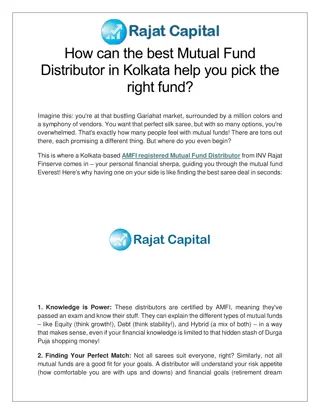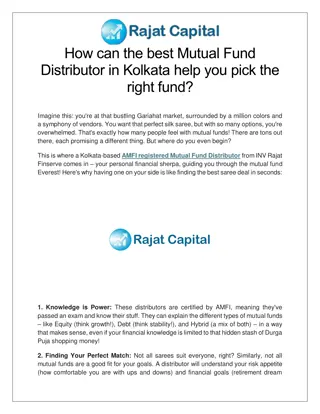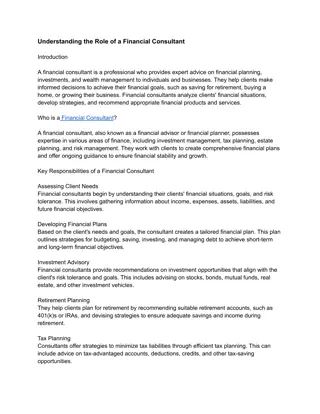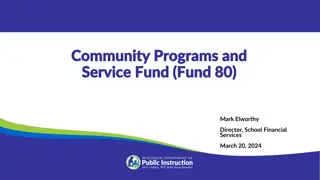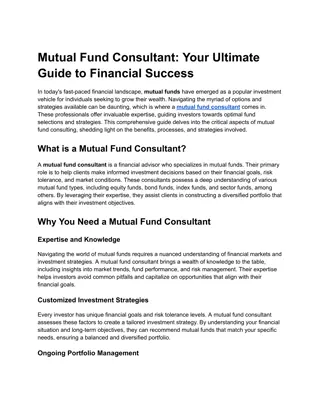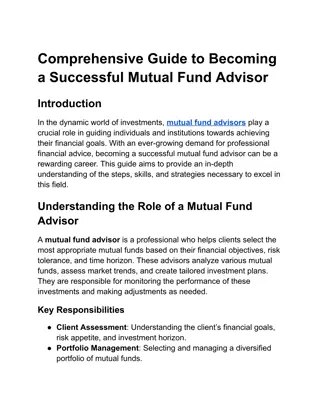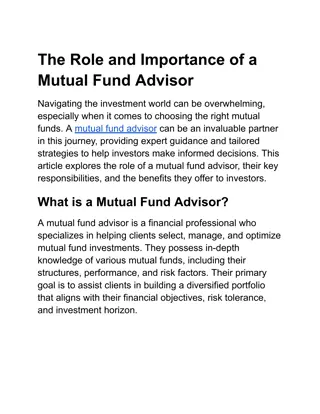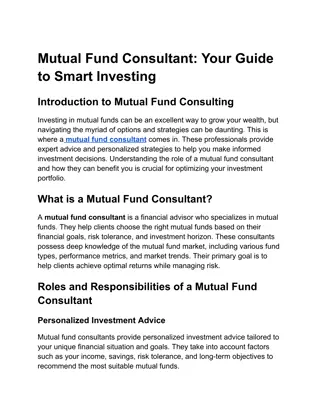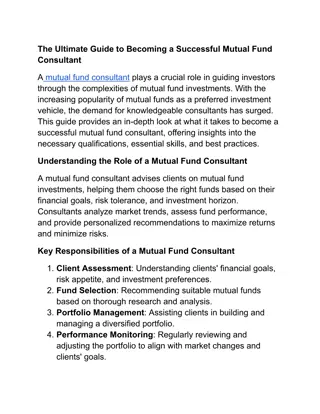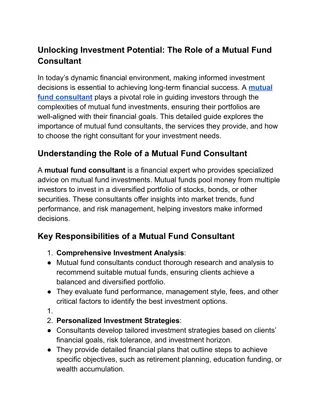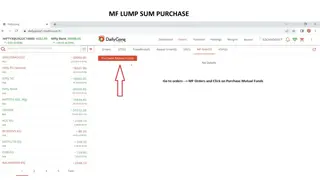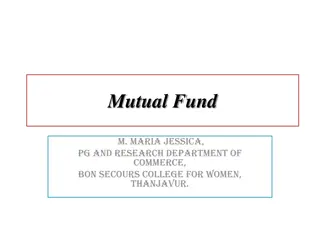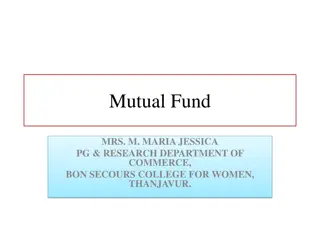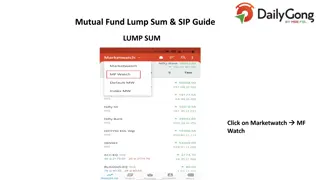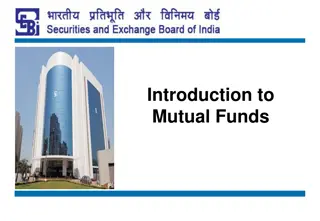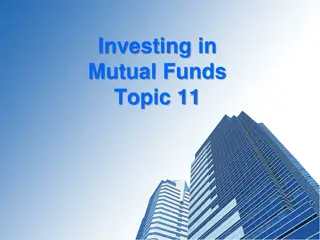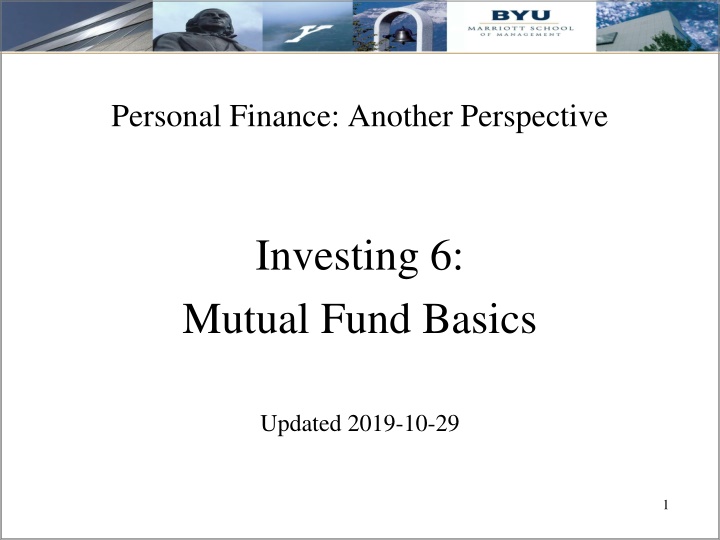
Mutual Fund Basics for Effective Investing
Explore the advantages, disadvantages, and types of mutual funds, learn how to calculate returns, and understand the costs involved in investing. Develop criteria for selecting mutual funds and create an investment plan using Morningstar for fund selection. Dive into the world of mutual funds for optimal investment strategies.
Download Presentation

Please find below an Image/Link to download the presentation.
The content on the website is provided AS IS for your information and personal use only. It may not be sold, licensed, or shared on other websites without obtaining consent from the author. If you encounter any issues during the download, it is possible that the publisher has removed the file from their server.
You are allowed to download the files provided on this website for personal or commercial use, subject to the condition that they are used lawfully. All files are the property of their respective owners.
The content on the website is provided AS IS for your information and personal use only. It may not be sold, licensed, or shared on other websites without obtaining consent from the author.
E N D
Presentation Transcript
Personal Finance: Another Perspective Investing 6: Mutual Fund Basics Updated 2019-10-29 1
Objectives A. Understand the advantages, disadvantages, types and classes of mutual fund shares B. Understand how to calculate mutual fund returns C. Understand the costs of investing in mutual funds and how to buy a mutual fund D. Understand plans and strategies for mutual funds 2
Investment Plan Assignments Investments 6: Mutual Fund Basics 1. Develop criteria that you can use to select a good mutual fund, index fund, or ETF for your portfolio. Remember an index fund is a mutual fund that just purchases the specific index shares 2. Using that criteria and Using Morningstar to Select Funds (LT07) pick one mutual fund minimum for each of your 4 asset classes (I recommend you have at least 4 asset classes minimum for diversification purposes), i.e., Emergency Fund, Core, Diversify, etc. For a spreadsheet with some ideas and a way to record Fund criteria, see Mutual Fund Selection Worksheet (LT7B) 3
Investment Plan Assignments (continued) Investments 8: Selecting Assets 1. Using your criteria for good mutual funds, use Morningstar or other programs to select your mutual/index funds for each of your asset classes 2. Print off the Snapshot page from Morningstar for each of your chosen Funds or assets (as well as for any mutual funds you may already own) 3. Include the chosen Fund names in your Exhibit 2: Investment Process Worksheet (TT13) with your target allocations 4. Assemble your completed Investment Plan including Exhibit 1 (LT23) and Exhibit 2 (LT13) 4
A. Understand the Advantages, Disadvantages, types and Classes of Mutual Funds What is a Mutual Fund? A way of holding financial and real investments An Investment company that pools money from investors to buy stocks, bonds, and other financial investments Investors own a share of the fund proportionate to the amount of their investment divided by the total value of the fund Why were they developed? To give smaller investors access to professional management and to increase the assets of mutual fund companies 5
Mutual Funds (continued) What are the advantages of Mutual Funds? Diversification Owning a mutual fund which holds numerous securities can reduce risk significantly Professional management Mutual funds are run by professional management who make the buy/sell decisions Minimal transaction costs Mutual funds enjoy economies of scale in purchases and sales due to size Liquidity Money from open-end mutual funds can be received in 2-3 business days 6
Mutual Funds (continued) Low cost No-load mutual funds are sold without a sales charge and are redeemed without a charge as well The ability to purchase and sell at Net Asset Value Open-end mutual funds can be purchased and sold each day at the fund s Net Asset Value Service Mutual funds generally offer service to answer questions, help you open accounts, purchase and sell funds, and to transfer funds as well. 7
Mutual Funds (continued) In addition, they may include: Automatic investment and withdrawal plans Automatic reinvestment of interest, dividends, and capital gains Wiring and funds express options Phone switching Easy establishment of retirement plans Check writing Bookkeeping and help with taxes 8
Mutual Funds (continued) What are the disadvantages of Mutual Fund Investing? Lower-than-market performance (if actively managed) From 1987-2019, most actively managed mutual funds underperformed their benchmarks (Dalbar QAIB 2018). High costs Unless analyzed, management and other fees (loads, 12-b1, sales charges) can be significant. 9
Mutual Funds (continued) Other Risks Mutual funds are subject to both market and stock related risks, particularly in concentrated portfolios Inability to plan taxes Mutual funds pass 95% of all income to shareholders, who must pay taxes on this each year, which may be difficult to plan for Premiums or Discounts Closed-end mutual funds may trade at a premium or discount to their underlying Net Asset Value New investor bias New investors dilute the value of the shares as this money must be invested (at roughly 0.5%). 10
Mutual Funds (continued) 11 Source: S&P SPIVA Scorecard 2019, S&P Indices Versus Active Funds (SPIVA) Scorecard , S&P Research, 2019 at http://www.spindices.com/documents/spiva/spiva-us-year-end-2018.pdf.
Types of Mutual Funds What are the major types of Mutual funds? The types of mutual funds generally follow the major asset classes Money market , stock, and bond mutual funds Others specialty mutual funds: Index funds Exchange Traded Funds (ETFs) Balanced funds Asset allocation funds Life-cycle funds 12
Types of Mutual Funds (continued) Money market mutual funds Money market mutual funds are funds which invest the majority of their assets in short-term liquid financial instruments such as commercial paper and government treasury bills Stock mutual funds Stock mutual funds are funds which invest a majority of their assets in common stocks of listed companies (8,293 U.S. stock funds as of 8/12/16 Morningstar) These funds generally have a specific objective, i.e. large-cap, small-cap , value, growth, , etc. which relates to the types of stocks the mutual fund invests in 13
Types of Mutual Funds (continued) Bond mutual funds Bond mutual funds are funds which invest a majority of their assets in bonds of specific types of companies or institutions (5,565 taxable bond funds as of 8/12/16) These funds generally have a specific objective, i.e. corporate, government , municipals, growth, , etc. which relates to the types of bonds the mutual fund invests in Index funds (1,065 as of 3/5/2019 Morningstar) Index funds are mutual funds designed to match the returns of a specific index or benchmark Index funds can track different benchmarks, with their goal is to match the return of the benchmarks 14
Types of Mutual Funds (continued) Exchange traded funds (ETFs) ETFs are portfolios of assets similar to mutual funds which trade on organized exchanges (2,688 as of 3/5/2019 - Morningstar) ETF s trade like stocks, purchased with transaction and custody costs, and priced throughout the day Asset allocation/Balanced funds Mutual funds which rotate asset classes among stocks, bonds, and cash for the best return Asset allocation funds invest the fund s assets in the asset classes expected to perform the best over the coming period of time 15
Types of Mutual Funds (continued) Life-cycle (or target date) funds Funds which change their allocation between stocks and bonds depending on investor age (2,682 as of 3/5/19) Hedge funds Hedge funds are less-regulated mutual funds which take much more risk than normal with the expectation of much higher returns Generally they can take both long positions (where they buy assets) and short positions (where they short-sell assets, i.e., borrow assets and sell them). They hope to later buy back the assets at a lower price before they must return them to the borrower 16
Classes of Mutual Fund Shares? Mutual funds are divided into classes of shares These classes of shares vary depending on the loads and management fees paid Loads are sales charges to compensate the sales force for selling the fund. Loads directly reduce the amount of money invested by the amount of the load Generally, research has found that the performance of load funds and no-load funds is identical. When the sales charges are included, no-load funds significantly outperform load funds. (Matthew R. Morley, Should You Carry a Load? A Comprehensive Analysis of Load and No-Load Mutual Fund Out-of-Sample Performance, Journal of Banking and Finance, vol. 27, nu. 7 (2003), pp. 1245-71.) 17
Classes of Mutual Funds (continued) While there are differences in classes of shares among investment management companies which charge loads, they generally are: Class A Shares: These shares commonly have a front-end or back-end load to compensate for the sales person s commissions. Because of the front- end loads, they usually have lower management fees Class B Shares: These shares commonly only have a back-end load that is paid only when the shares are sold. This load traditionally declines over time. Class B shares generally have higher expense ratios when compared to Class A shares 18
Classes of Mutual Funds (continued) Class C Shares: These shares generally have a lower front- and back-end load fees, but higher management fees Class R Shares: These shares are generally for retirement purposes. Check the loads and management fees which may be substantial No-Load Shares: These are shares sold without a commission or sales charge. Generally, these shares are distributed directly by the investment management company, instead of going through a sales channel. They may have higher management fees to compensate for the lack of a front- or back- end load 19
Classes of Mutual Funds (continued) Class Y Shares: These are shares with very high minimum investments, i.e., $500,000, but which have lower management fees and waived or limited load charges. These are generally for institutional investors Class Z Shares: These are shares only available for employees of the fund management company 20
Questions Do you understand the advantages, disadvantages, types and classes of mutual fund shares? 21
B. Understand how to Calculate Mutual Fund Returns How do you make money with mutual funds? Capital gains (i.e. appreciation market value) Capital gains are the best type of earnings as capital gains at the share level are not taxed until you sell your mutual fund shares. You decide when to sell your shares and get taxed Distributions (i.e., interest, dividends, realized capital gains, etc.) This is a less attractive type of earnings. Even though you do not sell any mutual fund shares and most investors reinvest earnings, you are still liable to pay taxes on all distributions that your mutual fund makes during the year 22
Mutual Fund Returns (continued) Distributions are divided into 5 main types: 1. Short-term capital gains Capital gains where the Fund has owned the assets for less than 12 months and which are taxed at your marginal tax rate 2. Long-term capital gains Capital gains where the Fund has owned the assets for more than a year (366 days) where are taxed at preferential rate dependent on your taxable income (See next slide) 23
Mutual Fund Returns (continued) 3. Qualified stock dividends Dividends by companies owned where the fund owned the shares for a specific length of time, and taxed at a preferential rate depending on taxable income 4. Ordinary (not-qualified) stock dividends Dividends by companies where the fund did not hold the stock for the required length of time, and taxed at your marginal tax rate 5. Bond interest and bond fund distributions Bond distributions are taxed at your federal and state Marginal Tax Rate 24
Mutual Fund Returns (continued) Chart 1. 2019 Tax Brackets, Capital Gains and Dividends, and Medicare Tax Rates (000s) Married Filing Filing Head of Ordinary & Dividends Single Jointly Household Income - - - 10% 9.70 19.40 13.85 12% 39.48 78.95 52.90 22% 39.38 78.75 52.75 84.20 168.40 84.20 24% 160.73 321.45 160.70 32% 204.10 408.20 204.10 35% 434.55 488.85 461.70 510.30 612.35 510.30 37% * Combined rate = 1.45% employer contribution. Cap. Gains Total Cap Gains & Medicare Medicare Tax Rate Tax Rate Earned Inc.* Invest. Inc. 0% 0% 2.9% 0% 2.9% 15% 2.9% 15% 2.9% 15% 2.9% 15% 2.9% 20% 3.8% 20% 3.8% 0.0% 0.0% 0.0% 0.0% 0.0% 0.0% 3.8% 3.8% 2.9% 2.9% 17.9% 17.9% 17.9% 17.9% 27.6% 27.6% 25
Mutual Fund Returns (continued) The key to after-tax returns is to understand the investment policy of the mutual fund (i.e., loads, turnover and distributions), and to invest in funds which have the highest after-tax return after all fees By looking at a fund s turnover, you can get an idea about how often the mutual funds managers turn over the portfolio, generating: Capital gains and losses Federal and state taxes, and Transactions costs These are all at the Fund level. Remember that you are taxed on these each year, even when your Fund loses money and when you have not sold the Fund 26
Mutual Fund Returns (continued) How do you calculate fund returns? Mutual fund returns include distributions of dividends, capital gains, and interest, and any NAV appreciation Total return: (ending NAV beginning NAV)+ distributions beginning NAV Make sure you adjust your beginning and ending NAV s to take into account the cost of both front- end and back-end loads! 27
Mutual Fund Returns (continued) Calculating before-tax returns With reinvestment of all distributions, total return includes the NAV share increase and the increased number of shares Total return: (#ES x EP) (#BS x BP) + Distributions (#BS x BP) #BS = beginning shares owned BP= beginning price #ES = ending shares owned EP = ending price 28
Mutual Fund Returns (continued) Calculating after-tax returns With reinvestment of all distributions, total return includes the NAV share increase and the increased number of shares. After-tax (AT) Total return is: (#Se x Pe) (#Sb x Pb) + SD + LCG + SCG + BDI (#Sb x Pb) Se = Shares Ending , Pe = Price Ending, Sb = Shares beginning , Pb = Price beginning, SD = Stock dividends * (1-(Fed+State tax rate)), LCG = Long-term cap gains * (1-(Fed+State tax rate)), SCG = Short-term cap gains * (1-(Fed+State tax rate)), BDI = Bond dividends/interest * (1-(Fed+State tax rate)) Note: If your state has state income tax, your state tax rate is included in the calculations 29
How to Buy a Mutual Fund and the Costs of Investing in Mutual Funds What are the steps to buying a mutual fund? 1. Determine your investment objectives, goals and your key principles of successful investing 2. Select your risk level, asset classes, asset allocation, and investment benchmarks 3. Identify funds in each asset class that meet your objectives and benchmark subject to your investment principles 4. Evaluate the funds and choose wisely based on your key investment principles 5. Send money or purchase online 30
Step 1. Determine your Investment Objectives What is the final purpose of the funds you will be investing? Know your personal goals and budget Determine your risk tolerance and return requirements for each goal Determine your investment constraints for each goal Determine where you are now in your investment program Determine which key principles are most important to this investment 31
Step 2: Choose Your Asset Classes What are the asset classes you want to follow? Know your risk tolerance and asset allocation Invest at a risk level you are comfortable with Keep your performance broadly based Choose a benchmark with many constituents Choose the benchmark that most matches the performance you are seeking Benchmark choice is very important Tell me your risk level and your asset class benchmarks, and I will tell you what your portfolio should look like 32
Step 3: Use a Database Program and Identify Funds That Meet Your Objectives One of the easiest ways to identify funds is to use financial publications and services You can access databases from which you can input your objectives and which will give you lists of possible funds. Examples include: Morningstar Mutual Funds Schwab One Source Other fee based databases Determine the fund s objective, asset class, and investment style Identify funds that meet your criteria for performance, size, fees, management, etc. 33
Step 4: Evaluate the Funds How do you evaluate funds (some advice from a fund manager in a previous career)? Always compare funds with the same objective Compare them to a relevant index Evaluate the fund s long-term performance versus peers and the relevant index Make sure they haven t inflated returns by buying outside their asset class. Look at returns in both up and down markets If they have historically under-performed peers and the index, avoid both and buy an index fund 34
Evaluate the Funds (continued) Look to the managers How long have they been managing the fund, and were they managing during good performance periods? Often good managers will leave when performance has been good to start their own firm, and others will come in later Size How much has the fund grown or shrunk? If a fund is losing assets, it generally sells its liquid assets first Often those left in a fund after liquidation are stuck with illiquid stocks that are harder to sell 35
Evaluate the Funds (continued) History How long has the fund been around? Has it changed its style? How did it perform under previous names and managers? Often fund companies will rename poorly performing funds and change investment objectives to mask poor performance Fees Watch the fee structures. Sometimes funds will add additional fees, i.e. 12-b1 fees, or impose rear-end loads to help increase revenues to themselves 12-b1 fees are paid by the shareholders and are just marketing fees. Avoid them 36
Evaluate the Funds (continued) Once you have selected a few funds, read each prospectus carefully Information in the Prospectus Fund information Goals and investment strategy Any limitations on investments that the fund may have, i.e., asset class constraints Any tax considerations of importance to the investors Services provided by the fund family The redemption and investment process for buying and selling shares in the fund Services provided to investors 37
Evaluate the Funds (continued) Information in the Prospectus Manager information The manager s past experience and how long he/she has been managing the fund Performance and fees Performance over the past 10 years, since inception, fund fees and expenses, annual turnover ratio, and minimum account size Printed Sources of Information The Wall Street Journal, Morningstar Mutual Funds, Forbes or Business Week, Kiplinger s Personal Finance, Smart Money or Consumer Reports Electronic Sources of Information www.fool.com Motley Fool www.morningstar.com Morningstar 38
Step 5: Make the Purchase If you are planning to buy the fund through a financial broker, banker, or planner: There is likely to be a load, or he will sell a class of share (i.e., R shares) which will rebate him a commission or charge an annual custody fee Watch clearly for the class of shares sold Research has shown, on average, that there is no statistical difference in performance between load and no-load mutual funds You will get all the services of the mutual fund company Ensure you can access your account through Quicken or other computer software 39
Make the Purchase (continued) If you plan to buy the fund directly from the mutual fund company: Most of the time they are no-load funds and have no custody costs You will get all the services of the mutual fund company, including an 800 number to call, internet access, and internet account information and servicing Check to make sure you can access your account through Quicken or other computer software Make sure your assets to be invested are more than the minimum account size 40
Make the Purchase (continued) If you plan to buy the fund through a mutual fund supermarket i.e., Fidelity Funds Network, Charles Schwab, or Jack White You get all the benefits of the mutual fund company, plus they are Quicken compatible You get access to a whole range of mutual fund companies (but not all of them) Mutual fund companies rebate part of their management fees back each month to the mutual fund supermarkets Minimum account balances vary Transaction fees vary, but generally no custody fee 41
Questions Any questions on the costs of mutual funds and on purchasing a mutual fund? 42
C. Understand the Costs of Mutual Funds What are the costs of mutual funds? Explicit costs Front-end Loads Sales commissions charged to the investor when purchasing certain types of fund shares. Back-end load funds Commissions charged to the investor when selling certain types of shares. This may be on a sliding scale No-load funds Funds where there are no commission charged 43
Costs of Mutual Funds (continued) Fees and expenses Management fees: Fee charged by the advisor to a fund generally on the basis of a percentage of average assets, i.e. 75 basis points or .75% a year 12b-1 fees: Fees charged to cover the fund s cost of advertising and marketing (why should you pay to market the funds to someone else?) Total expense ratio: the total percentage of assets that are spent each year to manage the fund including management fee, overhead costs, and 12b-1 fees 44
Costs of Mutual Funds (continued) Explicit costs (continued) Custody (or annual) fees These are fees the brokerage house charges to hold the mutual funds or ETFs in your account. May be a minimum amount for small accounts ($15 per year), a specific charge per holding (8 basis points per security), or a percentage of assets for large accounts (25 basis points on assets under management) 45
Costs of Mutual Funds (continued) Implicit costs Taxes on Distributions: Taxes must be taken into account to get the true return of your portfolio but which are not noted on your monthly reports Bond dividends and interest These are taxed at your marginal tax rate Stock dividends These are taxed at 15% or 0% Short-term capital gains These are taxed at your marginal tax rate Long-term capital gains These are taxed at 15% or 0% 46
Costs of Mutual Funds (continued) Hidden costs Transactions costs These are costs of the fund buying and selling securities, which are not included in other costs A good proxy for this is the turnover ratio. Turnover costs money and incurs taxes Hidden Costs (at the account level) Account Transfer Fees - Charges for moving assets either into or out Account maintenance fees - Fees for maintaining your account Inactivity/Minimum balance fees - Fees because you had no activity or did not keep a minimum balance 47
D. Understanding Plans and Strategies for Mutual Funds Following are a few ideas for your plans and strategies for mutual funds Plans and Strategies Overall What are acceptable investments? Mutual funds are good at doing what they do well, mitigating the risk of buying individual stocks and bonds by allowing the purchase of diversified portfolios of specific asset classes (IV.A-D.) Mutual/Index/Exchange Traded Funds are great alternatives to actively managed mutual funds, and offer cost, tax, and other advantages 48
Plans and Strategies for Mutual Funds (continued) Plans and Strategies General Investing Due to the many different types of stocks and bond mutual funds, investors can invest at differing risk levels with mutual funds Index funds/ETFs are great alternatives to actively managed mutual funds, and offer cost, tax, and other advantages While risk of individual stocks and bonds can be high, buying mutual funds can reduce that risk considerably 49
Plans and Strategies for Mutual Funds (continued) General Investing (continued) If you are choosing to put in a little each week or month, choose no-load mutual/index funds due to no transaction fee. If you are making one large purchase and holding it long-term, choose the ETF due to its slightly lower annual costs Remember that most actively managed funds fail to beat their benchmarks after all costs and fees, and most index funds return close to their benchmarks. 50

